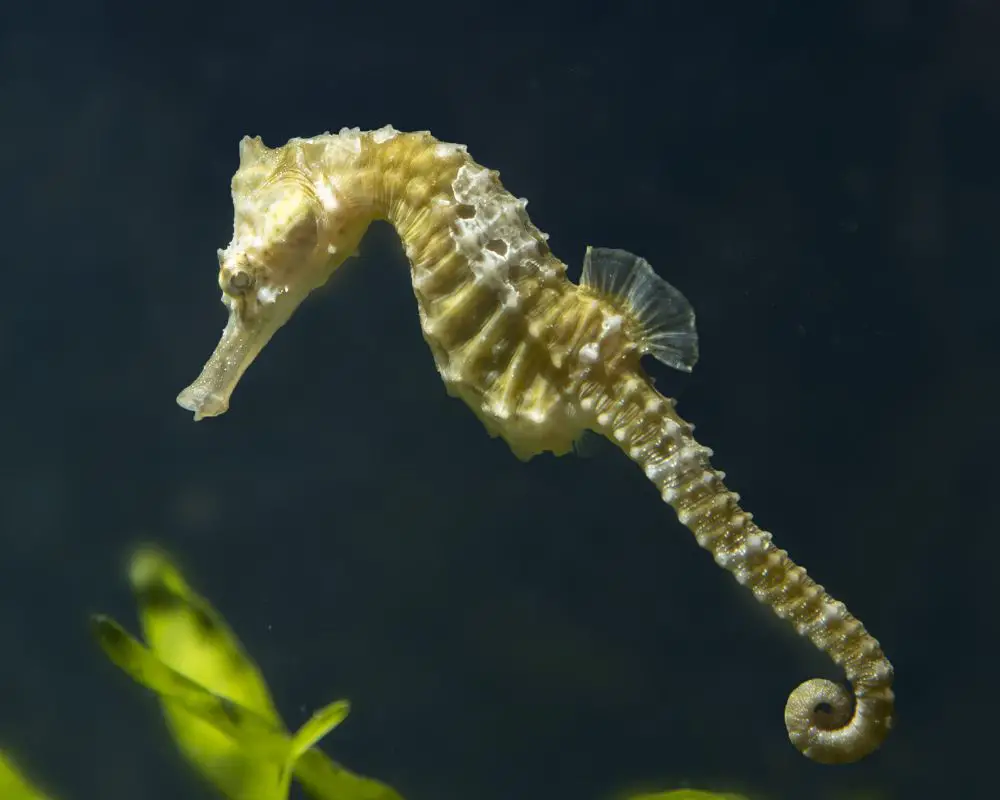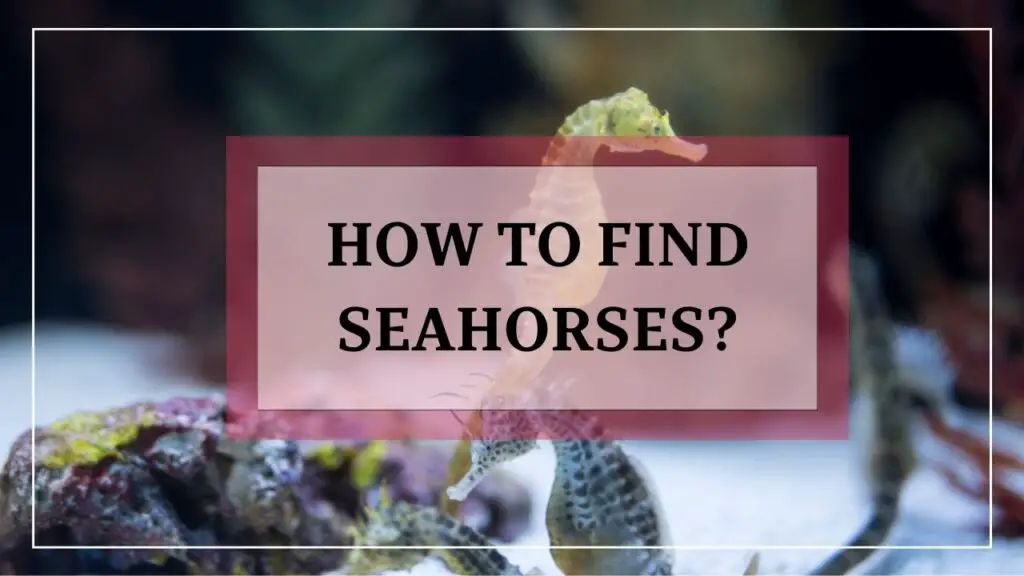These mystical creatures have captured the hearts and imaginations of many with their peculiar charm and captivating beauty. In this blog post, we’ll dive into the secrets of finding seahorses and uncovering the hidden treasures of their natural habitat.
I’m thrilled to guide you on this adventure, providing valuable tips and insights to help you spot these elusive creatures in their coastal realms.
So grab your snorkel and let’s embark on a journey to discover the wonders of seahorses and witness their delicate dance beneath the waves.
First, we need to learn about the different types of seahorses:
Types Of Seahorses

When it comes to seahorses, there’s more than meets the eye. These captivating creatures encompass a diverse range of species, each with its own unique characteristics and preferences. Let’s explore some of the different species of seahorses and the habitats they call home.
1. Common Seahorse (Hippocampus kuda):
The common seahorse is one of the most widespread species, found in the tropical waters of the Indo-Pacific region. They are known for their vibrant colors and intricate patterns. Common seahorses prefer shallow, sheltered areas such as seagrass beds, coral reefs, and estuaries.
2. Dwarf Seahorse (Hippocampus zosterae):
As the name suggests, the dwarf seahorse is one of the smallest seahorse species, measuring only about an inch in length. They are native to the warm coastal waters of the Gulf of Mexico and the Caribbean Sea. Dwarf seahorses often inhabit seagrass beds and coral reefs, clinging to seagrass blades with their prehensile tails.
3. Pot-Bellied Seahorse (Hippocampus abdominalis):
The pot-bellied seahorse is a larger species, reaching up to 12 inches in length. They are found in the coastal waters of Australia and New Zealand. These seahorses prefer rocky reefs, kelp forests, and seagrass meadows, where they can anchor themselves using their strong tails.
4. Tiger Tail Seahorse (Hippocampus comes):
The tiger-tail seahorse derives its name from its distinctive striped appearance, resembling a tiger’s tail. This species is native to the Indo-Pacific region and can be found in shallow coastal waters, including seagrass beds and mangrove forests.[1]
5. Thorny Seahorse (Hippocampus histrix):
As the name suggests, the thorny seahorse sports numerous spines on its body, providing excellent camouflage among coral reefs and rocky areas. They inhabit the waters of the Indo-Pacific region and are known for their impressive ability to mimic their surroundings.
While these are just a few examples, seahorses come in a variety of shapes, sizes, and colors. They all share a preference for shallow, coastal waters, often seeking refuge among seagrass beds, coral reefs, and mangroves. These habitats provide them with ample food sources and protection from strong currents.
Now, let’s move to some of the most important tips that will help increase your chances of finding a seahorse:
1. Choosing the Right Location
Finding seahorses is like embarking on a treasure hunt beneath the waves. But just like with any treasure hunt, you need to start in the right location:
The Importance Of Location
You’ve got your snorkel on, your excitement levels are soaring, and you’re ready to spot some seahorses. But hold your seahorses for a moment! Selecting the right location is key to maximizing your chances of a successful seahorse encounter. It’s like choosing the best ice cream parlor in town – you want the one with the tastiest flavors, right?
Characteristics Of Seahorse Habitats
Seahorses have a penchant for certain habitats that suit their whimsical lifestyles. Imagine seagrass beds, coral reefs, and mangroves as the VIP lounges where seahorses like to hang out. These habitats provide the seahorses with ample food, shelter, and camouflage options. It’s like finding the perfect beachside resort with a private cabana and a never-ending buffet!
Seagrass Beds: Ah, the lush meadows of seagrass! Seahorses adore these areas because they provide shelter, abundant food sources, and a playground for their graceful dances. It’s like a seahorse paradise with tall blades of grass to cling to and hide among – the perfect spot for a seahorse rendezvous.
Coral Reefs: Enter the bustling metropolises of the underwater world – coral reefs. These vibrant, bustling neighborhoods are home to a myriad of marine life, including seahorses. The intricate coral structures offer hiding spots and nooks for seahorses to rest and blend in. It’s like attending a fancy gala where seahorses are the celebrities strutting their stuff.
Mangroves: Prepare for a journey into the coastal jungles! Mangroves are dense forests of trees and roots that serve as a nursery and haven for countless marine creatures, including seahorses. The tangled roots create a natural maze, providing seahorses with shelter from predators and a cozy place to call home. It’s like exploring a hidden treasure trove where seahorses thrive among the twisted branches.
The Benefits Of Water Visibility And Minimal Disturbance
Just like you want a clear view of your favorite Netflix series, seahorses prefer good water visibility. Choosing a location with clear water allows you to spot these enchanting creatures from a distance and appreciate their delicate beauty. It’s like watching a fireworks display in high definition – every sparkle and shimmer becomes a mesmerizing spectacle.
2. Timing is Key
When it comes to finding seahorses, timing plays a vital role in increasing your chances of spotting these elusive creatures. So, let’s dive into the world of seahorse schedules and uncover the secrets of perfect timing!
Ideal TimeOf Day And Season
Just like we have our favorite times of the day, seahorses have their preferred moments too. When planning your seahorse expedition, keep in mind that they’re not early birds or night owls. Seahorses are most active during the daylight hours, so it’s best to schedule your underwater adventures accordingly. Imagine them as underwater sun worshippers, soaking up the rays and flaunting their fabulous seahorse style.
As for the ideal season, it’s like planning a vacation to a tropical paradise. Seahorses tend to be more active during warmer months when the water temperature is just right. Spring and summer provide the optimal conditions for seahorse sightings, with the waters teeming with life and seahorses in their prime. So, pack your swimsuit, grab your snorkel, and get ready for a seahorse rendezvous in the sunshine!
Sunlight And Tides – Nature’s Spotlight
Just like a spotlight illuminates the stage, sunlight plays a crucial role in seahorse behavior and visibility. When the sun’s rays penetrate the water, it creates a dazzling display of colors and enhances your chances of spotting these mesmerizing creatures. So, aim for those sunny days, my friend, when the underwater world becomes a vibrant kaleidoscope of beauty.
Now, let’s talk tides. Like a gentle ebb and flow, tides affect seahorses’ movements and behaviors. During high tides, seahorses may venture into shallower waters, exploring new areas and seeking out food sources. During low tides, they may retreat to slightly deeper areas, hiding among seagrass or coral crevices. So, keep an eye on the tides and plan your seahorse escapades accordingly – it’s like dancing to the rhythm of the sea.
The Mysterious Reproductive Cycles
Seahorses have a rather unique approach to love and family. It’s the males who become the dutiful fathers, carrying and nurturing the precious seahorse babies. Their reproductive cycles influence their behavior and presence in certain seasons. During mating season, male seahorses perform elaborate courtship dances to attract a suitable mate. Once the female deposits her eggs in the male’s pouch, he takes on the role of pregnancy and carries the developing babies until they’re ready to be released into the world.
During these reproductive cycles, seahorses may become more visible as they engage in courtship rituals or tend to their broods. So, keep an eye out during these special times when seahorses showcase their parental dedication. It’s like witnessing a heartwarming family affair in the underwater world.
3. Learning to Observe
When it comes to spotting these elusive creatures, a keen eye and a patient heart are your best allies. So, let’s dive into the world of seahorse observation and discover the secrets of becoming a seahorse detective!
Practical Tips For Observation
Observing seahorses is like playing a game of hide-and-seek but with a watery twist. To increase your chances of success, here are some practical tips to keep in mind:
1. Scan the Surroundings: Imagine yourself as a seahorse detective, scanning the underwater landscape for any telltale signs. Look for seagrass gently swaying, coral branches that seem to wiggle, or even tiny movements that catch your eye. These subtle clues may lead you to a hidden seahorse sanctuary.
2. Move Slowly and Silently: Stealth mode, engaged! To avoid startling or disturbing the seahorses, move slowly and gracefully through the water. Sudden movements and loud noises can send them scurrying for cover. Be the underwater ninja, my friend, and let your every move be as gentle as a mermaid’s whisper.
3. Utilize Peripheral Vision: Ah, the power of your peripheral vision! While focusing on one area, keep an eye on the periphery as well. Seahorses may suddenly appear in unexpected spots, like magical surprises waiting to be discovered. So, widen your gaze and let your underwater senses guide you.
The Importance Of Patience And Stillness
Patience is a virtue, my seahorse-seeking friend. When it comes to observing these enchanting creatures, patience is your secret weapon. Seahorses are masters of camouflage and may blend seamlessly into their surroundings. So, take a deep breath, relax, and embrace the stillness of the underwater world.
Find a comfortable spot near seagrass beds, coral reefs, or mangroves, and settle in for a peaceful wait. Allow the underwater symphony to serenade you while you keep a watchful eye. Remember, it’s like waiting for a shooting star – it may take time, but when it happens, it’s pure magic.
Avoid the temptation to chase after seahorses or disturb their delicate habitats. Treat them with the respect they deserve, and they will reward you with their captivating presence. It’s like being a courteous guest at a seahorse party – blend in, observe from a distance, and appreciate the natural beauty unfolding before your eyes.
Learn About Camouflage And Adaptations
Seahorses are the true masters of disguise, blending seamlessly into their surroundings with their remarkable camouflage abilities. Let’s explore how their coloration and body shape help them disappear into the underwater world.
Coloration: Nature’s Palette
Seahorses come in a variety of vibrant colors, from yellows and oranges to greens and browns. Their coloration allows them to match their environment, whether it’s the swaying seagrass or the intricate textures of coral reefs. They even have the ability to change their colors to reflect their mood or surroundings, like underwater mood rings.
Body Shape: Masterful Mimics
Seahorses’ slender bodies and elongated snouts mimic the swaying seagrass or delicate coral branches, making them expert mimics. They can also move their eyes independently, scanning their surroundings without revealing their position. It’s like having a 360-degree vision, all while remaining incognito.
Taking Your Precautions
Now that we’ve uncovered the secrets of finding seahorses, it’s important to talk about responsible seahorse viewing. As seahorse enthusiasts, we have a duty to protect these magical creatures and their habitats. So, let’s dive into the world of precautions and ensure our seahorse encounters are both memorable and respectful!
Hands Off, Please!
Seahorses may be enchanting, but they’re not for touching! It’s important to resist the urge to handle or disturb these delicate creatures. Their delicate bodies are not designed for human handling, and our touch can cause them harm or stress. Remember, we’re visitors in their world, and it’s essential to treat them with the respect they deserve.
Habitat Protection
Seahorses have specific habitats, such as seagrass beds, coral reefs, and mangroves, which are crucial for their survival. To safeguard their homes, it’s essential to avoid damaging or disturbing their habitats. Be mindful of where you swim or snorkel, and refrain from stepping on or damaging fragile underwater ecosystems. Together, let’s preserve their homes for future generations to enjoy.
Eco-Friendly Sunscreen And Respectful Behavior
We all love a sunny day at the beach, but did you know that certain sunscreens can harm marine life? It’s true! Some sunscreen ingredients can be toxic to seahorses and other marine organisms. So, when you’re getting ready for your seahorse adventure, choose an eco-friendly sunscreen that’s safe for both you and the underwater world. Let’s protect our skin and the seahorses at the same time!
Respectful behavior towards marine life goes beyond sunscreen choices. It’s about treating the underwater world as a sanctuary and its inhabitants as treasured guests. Avoid chasing or disturbing seahorses, as it can disrupt their natural behaviors and stress them out.
Observe from a respectful distance and let their beauty unfold naturally. Remember, we’re privileged to witness their underwater wonders, so let’s make sure we do it with care and consideration.
By taking precautions, avoiding touching or disturbing seahorses, protecting their habitats, using eco-friendly sunscreen, and behaving respectfully towards marine life, we can ensure that our seahorse encounters are responsible and sustainable. Let’s be stewards of the sea, my friend, and set an example for others to follow. Together, we can make a difference and safeguard these extraordinary creatures for generations to come. Happy and responsible seahorse viewing!

Hi, I’m Ali Tarek, the founder of Animalsman. I’ve always been passionate about pets, especially dogs and cats, and I created this website to share practical tips, easy recipes, and helpful care advice for fellow pet lovers. My goal is to make pet care simple, enjoyable, and accessible for everyone. When I’m not writing or curating content, you’ll usually find me spending time with my furry friends or learning new ways to keep them happy and healthy.



